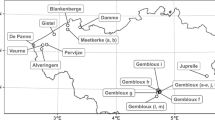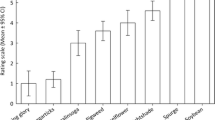Abstract
The parasitism of Bemisia tabaci (Gennadius) was evaluated on three horticultural crops in the Nicaraguan dry tropic: tomato, Lycopersicon esculentum Mill; squash, Cucurbita argyrosperma (Huber); and sweet pepper, Capsicum annuum L. Parasitoid species were identified and their abundance recorded on the three crops. The study was carried out during both the rainy and dry seasons between 2001 and 2002. The nymphs of B. tabaci were counted weekly and parasitism rates evaluated. During the rainy season, the predominant parasitoids in squash and tomato crops were Encarsia pergandiella Howard and E. nigricephala Dozier. Parasitism rates of 17 and 10% were recorded for squash and tomato, respectively. In sweet pepper, the parasitoid species were E. pergandiella, E. nigricephala, E. desantisi Viggiani and Amitus sp. with a parasitism rate of 12%. During the dry season, the parasitoids in squash were E. pergandiella and E. nigricephala with a parasitism rate of 57%. Encarsia pergandiella was the only species noted in tomato with a parasitism rate of 58%, while in sweet pepper the species noted were E. pergandiella and E. nigricephala, with a 42% rate of parasitism. The abundance of parasitoids remained stable during both sampling seasons. Our results suggest that the parasitism rate is independent of B. tabaci densities. This is the first mention of E. pergandiella, E. nigricephala, E. desantisi and Amitus sp. as parasitoids of B. tabaci in Nicaragua.
Résumé
Le parasitismede lamouche blanche Bemisia tabaci (Gennadius) a été évalué en zone tropicale sèche nicaraguayenne, sur trois cultures maraîchères: tomate, Lycopersicon esculentum Mill., courge, Cucurbita argyrosperma Huber et poivron, Capsicum annuum L. L’objectif du travail était d’identifier les parasitoïdes natifs de B. tabaci et d’évaluer les taux de parasitisme apparent. L’étude a été réalisée en 2001–2002 durant la saison des pluies ainsi qu’au début de la saison sèche 2001. Le nombre de larves de B. tabaci par feuille a été compté hebdomadairement. Pendant la saison des pluies, les parasitoïdes dominants en cultures de courge et tomate sont Encarsia pergandiella Howard et E. nigricephala Dozier. Les taux moyens de parasitisme sont de 17 et 10%pour les cultures de courge et de tomate, respectivement. Sur poivron, les espèces rencontrées sont E. pergandiella, E. nigricephala, E. desantisi Viggiani et Amitus sp. avec un taux de parasitisme de 12%. Pendant la saison sèche, les parasitoïdes rencontrés sur courge sont E. pergandiella et E. nigricephala, avec un taux de parasitisme de 57%. Sur tomate, la seule espèce trouvée, E. pergandiella, est responsable d’un taux de parasitisme de 58%, tandis que sur le poivron, les espèces sont E. pergandiella et E. nigricephala, avecuntauxdeparasitismede 42%.Lenombredeparasitoïdes est resté stabledurant lesdeux saisons d’échantillonnage. Nos résultats suggèrent que le taux de parasitisme apparent est indépendant de la densité de B. tabaci. C’est la première fois que E. pergandiella, E. nigricephala, E. desantisi et Amitus sp. sont mentionnés comme parasitoïdes de B. tabaci au Nicaragua.
Similar content being viewed by others
Références
Bogran C. A., Obrycki J. et Cave R. (1998) Assessment of biological control of Bemisia tabaci (Homoptera: Aleyrodidae) on common bean in Honduras. Florida Entomologist 80, 384–395.
Brown J. K., Frohlich D. R. et Rosell R. C. (1995) The sweetpotato or silverleaf whiteflies: Biotypes of Bemisia tabaci or a species complex? Annual Review of Entomology 40, 511–534.
Cave R. D. (Ed.) (1995) Manual para el Reconocimiento de Parasitoïdes de Plagas Agrícolas en America Central. Zamorano Academia Press, Zamorano, Honduras. 202 pp.
Gerling D. (1985) Parasitoids attacking Bemisia tabaci (Hom. Aleyrodidae) in eastern Africa. Entomophaga 30, 163–165.
Gerling D. (2002) Una reinterpretación sobre las moscas blancas. Manejo Integrado de Plagas (Costa Rica) 63, 13–21.
Greathead D. J. (1991) Biological control in the tropics: Present opportunities and future prospects. Insect Science and Its Application 12, 3–8.
Hilje L. (1995) Aspectos bioecológicos de Bemisia tabaci en Mesoamérica. Manejo Integrado de Plagas (Costa Rica) 35, 46–54.
Hoelmer K. A., Kira A. A. et Simmons G. S. (1999) An overview of natural enemy explorations and evaluations for Bemisia in the U.S., pp. 689–696. In Proceedings of the 5th International Conference on Animal Pests in Agriculture, Montpellier, France. Association Nationale de Protection des Plantes, Paris.
INTA (1999) Guia tecnologica 22. Cultivo del tomate. Departamento de servicios tecnicos de apoyo (DSTA), Managua, Nicaragua. 55 pp.
Joyce A. L. et Bellows T. S. (2000) Field evaluation of Amitus bennetti (Hymenoptera: Platygasteridae), a parasitoid of Bemisia argentifolii (Hemiptera: Aleyrodidae), in cotton and bean. BioControl 17, 258–266.
Maes J. -M. (2000) Insectos asociados con cultivos tropicales Museo entomológico de León. Nicaragua. versión CD-ROM.
Manzano M. R., Van Lenteren J. C. et Cardona C. (2003) Influence of pesticide treatments on the dynamics of whiteflies and associated parasitoids in snap bean fields. BioControl 48, 685–693.
Markham P. G., Bedford I. D., Liu S., Frolich D. R., Rosell R. et Brown J. K. (1996) The transmission of geminivirus by biotypes of Bemisia tabaci (Gennadius), pp. 69–75. In Bemisia 1995: Taxonomy, Biology, Damage, Control and Management (Edited by D. Gerling and R. T. Mayer). Intercept, Andover, UK.
McAuslane H. J., Johnson F. A. et Knauft D. A. (1994) Population levels and parasitism of Bemisia tabaci (Gennadius) (Homoptera: Aleyrodidae) on peanut cultivars. Environmental Entomology 23, 1203–1210.
Perring T. M. (1996) Biological differences of two species of Bemisia that contribute to adaptive advantage, pp. 1–16. In Bemisia 1995: Taxonomy, Biology, Damage, Control and Management (Edited by D. Gerling and R. T. Mayer). Intercept, Andover, UK.
Polaszek A., Evans G. A. et Bennett F. D. (1992) Encarsia (Hymenoptera: Aphelinidae) parasitoids of Bemisia tabaci (Homoptera: Aleyrodidae): A preliminary guide to identification. Bulletin of Entomological Research 82, 375–392.
Riley D. G. et Ciomperlik M. A. (1997) Regional population dynamics of whitefly (Homoptera: Aleyrodidae) and associated parasitoids (Hymenoptera: Aphelinidae). Environmental Entomology 26, 1049–1055.
Ryckewaert P. et Alauzet C. (2002) The natural enemies of Bemisia argentifolii in Martinique. BioControl 47, 115–126.
SAS Institute (2003) JMP® 5.1.2 statistical analysis software, for windows. SAS Institute, Cary, North Carolina.
Schuster D. J., Evans G. A., Bennett F. D., Stansly P. A., Jansson R. K. et Leibee G. L. (1998) A survey of parasitoids of Bemisia spp. whiteflies in Florida, the Caribbean, and Central and South America. International Journal of Pest Management 44, 255–260.
Simmons A. M. (1998) Survey of the parasitoids of Bemisia argentifolii (Homoptera: Aleyrodidae) in coastal South Carolina using yellow sticky traps. Journal of Entomological Science 33, 7–14.
Simmons A. M. et Jackson D. M. (2000) Evaluation of foliar-applied insecticides on abundance of parasi- toids of Bemisia argentifolii (Homoptera: Aleyrodidae) in vegetables. Journal of Entomological Science 35, 1–8.
Smith H. A., Evans G. A. et Mcsorley R. (2000) A survey of parasitoids of Trialeurodes vaporariorum and Bemisia tabaci (Homoptera: Aleyrodidae) in eastern Guatemala. Florida Entomologist 83, 492–496.
Smith H. A., Mcsorley R. et Izaguirre J. A. S. (2001) Effect of intercropping common bean with poor hosts and nonhosts on numbers of immature whiteflies (Homoptera: Aleyrodidae) in the Salama Valley, Guatemala. Environmental Entomology 30, 89–100.
Van Lenteren J. C. et Noldus L. P. J. J. (1990) Whiteflyplant relationships: Behavioural and ecological aspects, pp. 47–89. In Whiteflies: Their Bionomics, Pest Status and Management (Edited by D. Gerling). Athenaeum, Newcastle, UK.
Author information
Authors and Affiliations
Corresponding author
Rights and permissions
About this article
Cite this article
Nunes, C., Lucas, É. & Coderre, D. Parasitisme de Bemisia tabaci (Homoptera: Aleyrodidae) en cultures maraîchères en tropique sec nicaraguayen. Int J Trop Insect Sci 26, 57–63 (2006). https://doi.org/10.1079/IJT200697
Accepted:
Published:
Issue Date:
DOI: https://doi.org/10.1079/IJT200697




